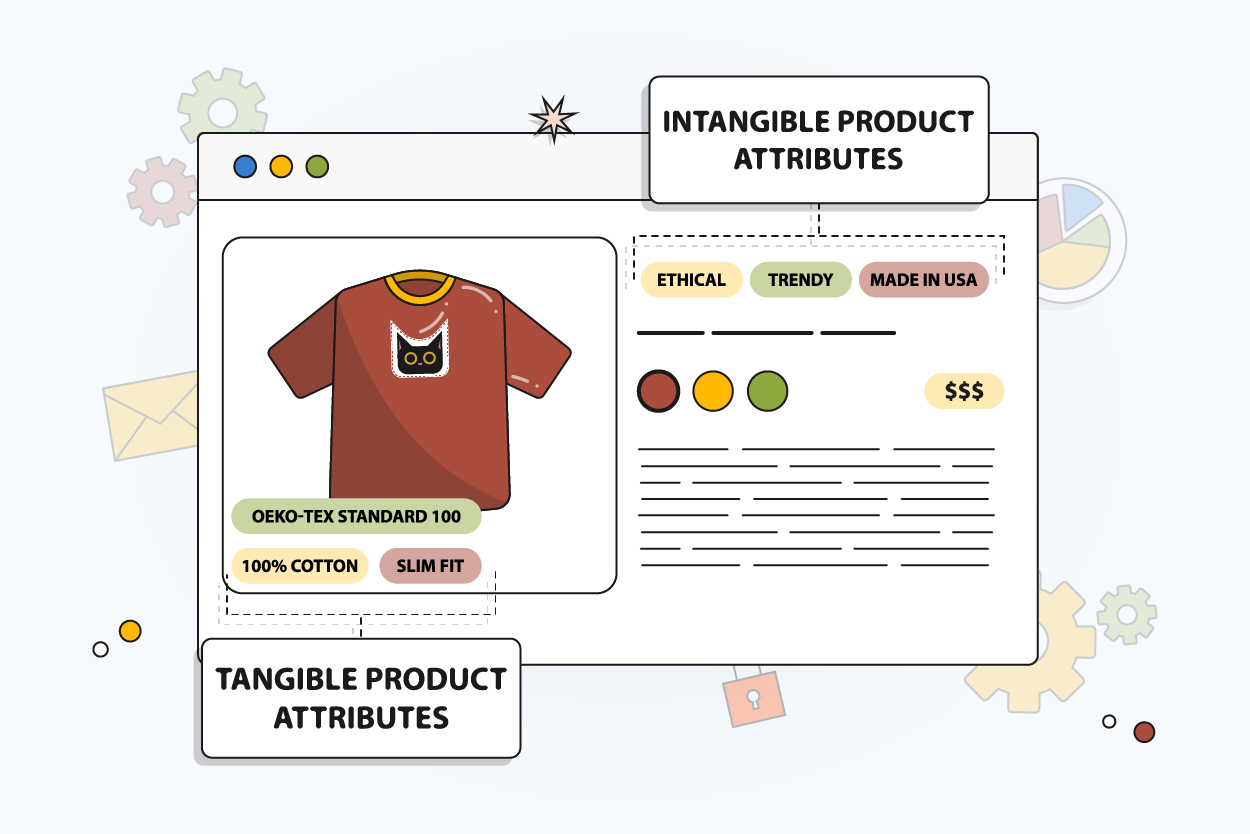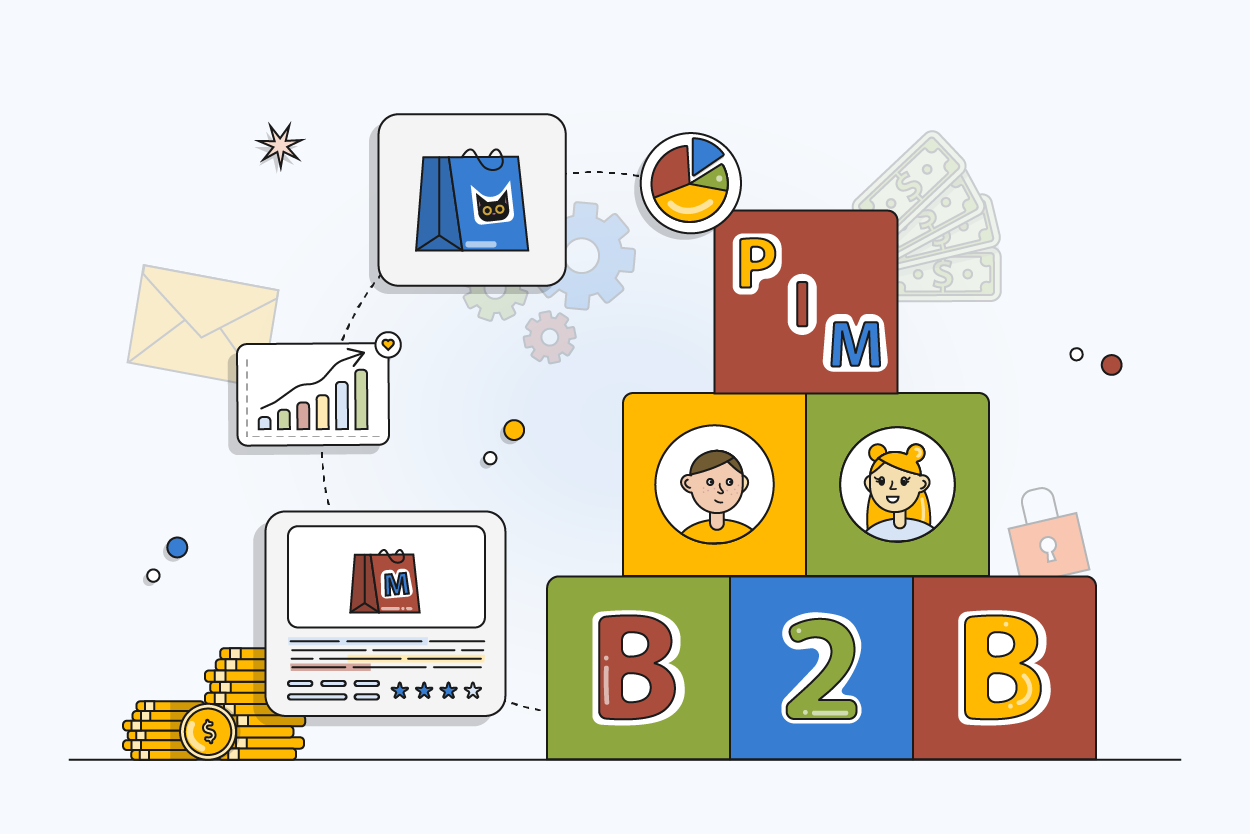Blog » Product Attributes in B2B Ecommerce: Best Practices and Examples for 2025
Product Attributes in B2B Ecommerce: Best Practices and Examples for 2025
Author name: Bradley Taylor
B2B buyers need clear, detailed information to make smart purchasing decisions. Product attributes serve as the backbone of this information exchange. They help companies showcase their offerings effectively while enabling buyers to find exactly what they need.
This level of detail has become even more important as B2B purchasing behavior continues to shift online. A recent study found that 59% of business-to-business (B2B) buyers now make a quarter of their purchases online. Rich and precise product attributes can be a strategic differentiator in this digital-first world.
In this post, we’ll break down what product attributes are, explore the different types, and show why they’re a key driver of success in modern B2B e-commerce.
What Are Product Attributes?
Product attributes are the specific characteristics or features that define a product. Think of them as the DNA of your product catalog. They're what make each item unique and searchable.
Buyers can compare technical specifications, regulatory compliance, and compatibility between various products in B2B e-commerce thanks to attributes. This is critical as B2B purchase choices usually depend on specific product features that impact business operations.
By comparison, consumer attributes (B2C) are often less complex, as emotional factors frequently influence purchases more than specific functional requirements.
Your online catalog's filters, search features, and product configuration tools are powered by the characteristics defined in attributes. Even the greatest products may go unnoticed by prospective customers in the absence of strong product attribution.

Types of Product Attributes
The attributes of a product come in several forms, each serving different needs in the buyer journey. Understanding these types helps create a comprehensive product information strategy.
1. Tangible Product Attributes
These are the physical, measurable features that define what a product is at its core:
- Technical specifications like dimensions, weight, materials, and pressure ratings.
- Performance characteristics such as speed, throughput, load capacity, and efficiency.
- Compatibility information that defines which systems, components, or standards the product integrates with.
- Packaging and unit details like quantity per box, pallet dimensions, or shipping weight.
For example, an industrial valve might list tangible attributes such as:
- 3-inch diameter.
- 316 stainless steel body.
- 500 PSI pressure rating.
- Temperature range: -20°F to 400°F.
- Threaded NPT connections.
These concrete attributes allow buyers, engineers, and procurement teams to assess fit and function with confidence.
2. Intangible Attributes
Not all important product attributes are physical. Intangible attributes often prove just as crucial in B2B decision-making. They provide reassurance, communicate value, and help differentiate similar products.
- Certifications and compliance marks (NSF-61, UL Listed, RoHS, CE).
- Environmental or sustainability ratings (Energy Star, recyclable materials, carbon footprint).
- Warranty coverage and service terms.
- Brand reputation or trust signals.
- Customer support and documentation availability.
- Value propositions like “Made in USA,” or “industry-leading uptime”.
These key attributes address the "beyond the product" factors that matter to business buyers concerned with total cost of ownership and ongoing support. Often referred to as marketing attributes, they help highlight product benefits in ways that tangible attributes cannot.
How Product Attribution Shapes the B2B Buyer Journey
B2B buyers require precision, especially when buying in bulk or for manufacturing processes. The right product attributes streamline each stage of their journey.
During initial research, detailed attributes help buyers quickly determine whether products meet their basic requirements. For example, a manufacturing company seeking replacement parts can immediately filter by compatibility with existing equipment, saving valuable time.
As buyers move to comparing vendors, attributes enable side-by-side evaluation of technical specifications, pricing structures, and service offerings. This comparison phase relies heavily on standardized product attributes to ensure fair assessment.
Finally, attributes play a key role in the approval process. Procurement teams often need to justify purchases to stakeholders, and detailed product information makes building a business case easier.
The stakes are high for suppliers. 75% of B2B buyers say they’d switch vendors for a better online purchasing experience.

Examples of Product Attributes
Product attributes vary widely depending on the industry. However, many core attributes are used across categories to help define, differentiate, and describe products. Common examples include:
- Size/Dimensions.
- Color/Finish.
- Weight.
- Material.
- Power Requirements (Voltage, Amperage, etc.).
- Certifications/Compliance Marks.
These foundational attributes form the basis of most product listings and are often supplemented by more specialized information based on the product’s function or target audience. Below are some examples from specific industries:
HVAC and Industrial Equipment
A commercial HVAC component might feature:
- Dimensions (32" x 24" x 18")
- Material (Galvanized Steel)
- Voltage (220V)
- BTU rating
- Compatible systems (list of compatible SKUs)
- Compliance (AHRI certified)
Scientific and Laboratory Equipment
A lab equipment supplier might include:
- Temperature range
- Certification (CE, ISO 13485)
- Origin (Made in Germany)
- Sterilization method
Apparel Goods
A wholesale apparel distributor could list:
- Fabric weight (6.5 oz)
- Sleeve type
- Fit (relaxed, standard)
- Customization options (embroidery, screenprint)
These examples show how different industries prioritize various attributes based on what matters most to their customers.
Why Are Product Attributes Important?
Strong product attribution delivers multiple benefits across your e-commerce operations:
- Helping customers find the right product faster.
- Enabling deep filtering and accurate comparison.
- Reducing returns due to misunderstandings.
- Enhancing syndication and SEO for e-commerce product visibility.
- Simplifying the onboarding of new products into your catalog.
Here is a deeper look at how this can apply to today’s B2B commerce companies:
Product Attributes Improve Website Discovery and Search
A construction supply site can use granular product attributes to allow filtering by diameter, PSI rating, and coating type, cutting down product selection time from 5 minutes to 30 seconds. This efficiency drives repeat business as customers appreciate the time savings.
The site's search function also leverages these attributes, ensuring relevant results appear when customers search for specific product characteristics. This improved search relevance directly impacts conversion rates and customer satisfaction.
Attributes Prevent Errors and Reduce Returns
A medical device supplier includes compatibility attributes for every SKU, reducing mismatched purchases and returns. This improvement not only saves on return processing costs but also builds trust with customers who now experience fewer ordering mistakes.
Clear product attributes also help prevent ordering errors in the first place. When customers can easily see which products meet their exact needs, they make better purchasing decisions without needing to contact customer service for clarification.

Product Data Powers SEO and Channel Syndication
Well-structured product attributes feed into schema markup, product tags, and feeds, improving your listings' performance across Google Shopping, search engines, and sales channels. Clean, consistent attributes make your products more discoverable and clickable, both in organic results and paid feeds.
Products with full attribute sets frequently rank higher and are more visible in marketplaces and procurement portals. Listings that give buyers the comprehensive information they need to make educated decisions are given priority on many B2B platforms.
How to Create Effective Product Attributes?
Creating useful product attributes requires strategic thinking about your customers' needs and your operational capabilities.
Start by aligning attributes with customer needs and buying processes. Recognize the information your buyers require at each stage of the decision-making process. Using a customer-centric approach guarantees that you are giving pertinent information instead of merely technical details that may not be important.
Use attribute templates for consistency across product categories. This structured approach helps maintain quality standards while making it easier to onboard new products.
Create scalable taxonomies and naming conventions that can grow with your business. As you add product categories or enter new markets, a flexible attribute framework prevents the need for major overhauls.
Always include units of measurement, and be consistent across your catalog. Don't mix imperial and metric units without clear labeling, as this creates confusion and potential ordering errors.
Let’s see how different types of B2B companies can turn this into action:
Refine Attributes by Segment
Engineers (detailed technical specs) and procurement teams (pricing, availability, warranty) need different attribute sets at a B2B electronics retailer. This segmented approach acknowledges that different stakeholders require varied information to make decisions.
You can assist different decision-makers without overloading any one user with superfluous details by developing role-specific views of product information.
Dynamic Attributes by Channel
A manufacturer syndicates different attribute sets to Amazon Business, Alibaba, and its own portal, optimized for each channel's needs. This channel-specific approach recognizes that marketplace requirements and customer expectations vary across platforms.
Adjusting attributes to each channel lets you maximize visibility and conversion opportunities wherever your products appear.
Using AI to Generate or Map Attributes
Leveraging AI to extract attributes from PDFs, datasheets, or product catalogs at scale represents the cutting edge of product attribution. Modern AI tools can process thousands of technical documents to create standardized attribute sets, dramatically reducing the manual effort required.
This automated approach proves especially valuable when onboarding large product catalogs or integrating acquisitions with different attribute structures.
Common Challenges with Managing Product Attributes
Even with the best strategies, companies face several common hurdles with product attribution:
1. Inconsistent Data
Cross-departmental input often creates conflicts in how attributes are defined and measured. Engineering might use technical terminology, while marketing prefers benefit-oriented language.
Supplier data varies widely in format and completeness, requiring normalization before it can be used effectively. This variability creates extra work and potential for errors.
2. Inaccurate or Missing Information
Incomplete attributes directly impact purchase decisions. When buyers can't find critical information, they often move to competitors rather than reaching out with questions.
You address this potential problem by implementing validation methods to catch errors before they reach your catalog. Automated checks for logical inconsistencies (like products with impossible dimensions) can flag potential issues for review.
Additionally, consider using completeness scoring to track attribute quality across your catalog. This approach can also help you optimize enrichment efforts toward the most visible or valuable products.
3. Organization and Prioritization
Developing an attribute hierarchy helps distinguish between must-have and nice-to-have information. Not all attributes deserve equal prominence in your product display.
You can balance industry-specific technical attributes with cross-category information that applies broadly. This layered approach makes your catalog navigable both by specialists and general procurement staff.
Prioritize attributes that drive search and filtering behavior. Analytics can reveal which attributes customers use most frequently to narrow their product selections.
4. Data Management Challenges
The sheer scale of attributes can become overwhelming as catalogs grow. A single complex product might have hundreds of potential attributes to manage.
Attributes require regular updates as products evolve or regulations change. Establishing clear update processes ensures information stays current across your entire catalog.
Cross-platform consistency becomes challenging when selling through multiple channels, each with different attribute requirements or formats.
5. Legal and Ethical Issues
Accuracy isn't just good for business, it's often a legal requirement. Claims made through product attributes must be substantiated, particularly for regulated industries.
Regional regulations may require different attributes to be disclosed based on where products are sold. Managing these variations adds complexity to global operations.
What Must You Do Before You Can Create a Product Attribute?
Before diving into attribute creation, several preparatory steps ensure your efforts succeed:
Conduct Customer Research
Interview customers about what information they need when making purchasing decisions. Their priorities might differ from your internal assumptions.
Analyze search terms and filter usage on your existing site to identify information gaps. Patterns in search behavior reveal what attributes customers value most.
Review competitor product listings to benchmark your attribute strategy. This competitive analysis helps identify industry standards and opportunities to differentiate.
Establish Attribute Governance
Assign clear ownership for attribute management across departments. This accountability prevents conflicting updates and ensures quality standards.
Develop approval workflows for adding or modifying attributes, especially for regulated products where accuracy carries legal implications.
Create update schedules that balance freshness with operational efficiency. Not all attributes need real-time updates, but critical information should never be outdated.
Develop Standardized Naming Conventions
Create consistent naming conventions that make attributes intuitive for users and manageable for your team. When an attributes list follows logical patterns, both customers and staff benefit.
Establish format standards for attribute values, including acceptable units, ranges, and terminology. This consistency improves searchability and prevents confusion.
Consider multilingual requirements early if you serve international markets. Some attributes may need adaptation rather than direct translation to be meaningful across cultures.
Create Data Quality Standards
Define minimum completeness requirements for products to be published. A product with only basic attributes might not provide enough information for B2B buyers to make decisions.
Implement verification processes, especially for high-value or technical products where accuracy directly impacts customer operations.
Establish metrics for monitoring attribute quality over time. Regular audits help maintain standards as your catalog expands.
Plan for Scalability
Design your attribute structure with future growth in mind. New product lines should fit into your existing framework without requiring major restructuring.
Consider how attributes will be inherited across product families to minimize duplicate work. Parent-child relationships between products can streamline attribute management.
Identify opportunities for automation in attribute creation and validation. As your catalog grows, manual processes become increasingly impractical.
How PIM Software Helps with Product Attributes
Product Information Management (PIM) software provides the infrastructure needed for effective attribute management in complex B2B environments.
Modern PIM solutions centralize attribute management, creating a single source of truth across all sales channels and supporting digital asset management to ensure product visuals and documents are properly connected to attributes. This centralization eliminates inconsistencies that arise from managing attributes in multiple systems.
PIM systems enable attribute inheritance and propagation, allowing changes at the product category level to flow down to individual items automatically. This capability drastically reduces the time required to update common attributes across large product groups.
Workflow and approval automation ensure that attribute changes follow established governance processes. These workflows maintain quality standards while tracking who made changes and when.
Data quality features continuously assess attribute completeness and consistency, flagging issues before they affect customer experience. These automated checks scale with your catalog in ways manual review cannot.
Channel-specific mapping capabilities transform your master attribute set to meet the requirements of different sales platforms. This flexibility ensures optimal presentation wherever your products appear.
Conclusion
Companies that offer the most helpful product information have a competitive edge as procurement procedures become more digital.
Product attributes with a clear structure lower friction, speed up purchasing decisions, and increase return on investment for both buyers and sellers. They make it possible for B2B clients to have the accuracy and effectiveness that they require.
PIMinto stands at the forefront of this revolution in B2B product information management. Our PIM solution has strong attribute management features that grow with your company, making it ideal for the intricate requirements of B2B trade.
The user-friendly interface of PIMinto ensures accuracy and consistency across your digital ecosystem by making it simple to create, arrange, and distribute thorough product attributes across all of your sales channels.
Modified on: 04/30/2025
